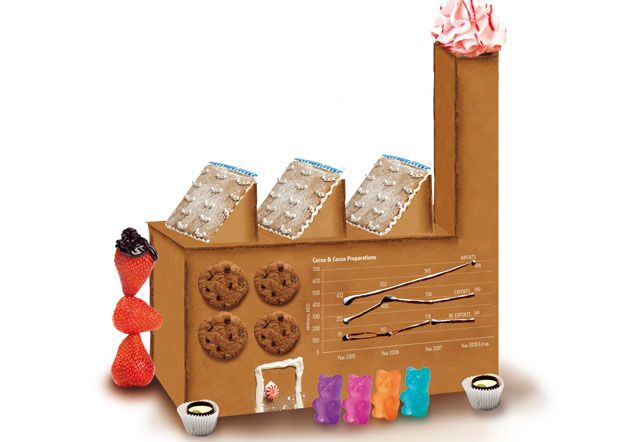Dubai: It sounds surprising, but the sugar and confectionery business makes up the largest part of UAE food product exports. Valued at Dh1.3 billion, it accounts for 37 per cent of the export value of all food products, according to recent figures from the Dubai Export Development Corporation.
The sweets and confectionery market alone is worth Dh300 million in the UAE and is growing by 10 per cent annually, says Jon Barber, public relations manager of Exhibition and Events Management at Dubai World Trade Centre. That's one of the reasons why the Sweets Middle East Exhibition at the International Convention Centre this week was well attended again.
"Having a booth at the Sweets Middle East is essential for us," Martin van Almsick, general manager of Al Nassma chocolates, told Gulf News at the exhibition. He just came from the New York Chocolate Show, held at the end of October, to promote his UAE-produced camel milk chocolate. "There is a high interest from the US in our products, and they are starting to look at the UAE as a producer." Besides that, the sweets fair in Dubai remains the most important networking event in the region.
At the Sweets Middle East, which was held together with the inaugural Sweet & SnackTec Middle East exhibition, 16 out of some 150 companies were from the UAE, either as trade firms or as producers. Several of them have a long history in the country, for example Hunter Foods, which has been manufacturing special gourmet snacks in the Jebel Ali free zone since 1985, says General Manager Gao Yan. Others, like Fuala, started local manufacturing in 2002 "to stand against imported foods," says sales manager Adnan Adil Absi.
150 companies
Out of the more than 150 companies from 35 countries exhibiting at the Sweets Middle East, participants from countries like Azerbaijan, Hong Kong, Singapore, Spain, Bulgaria, the Czech Republic, Lithuania, Portugal, Denmark and the UK came for the first time. To bring all the traders together, Dubai Municipality has set up an "International Buyers Centre" at the exhibition, says Trixee Loh, senior vice-president of Exhibitions at the Dubai World Trade Centre.
The 2008 exhibition welcomed eight national pavilions, 160 companies from 32 countries and a total of 4,545 trade visitors attending from 75 countries.
As for the confectionery market in the Middle East, the market is identified to be one of the top ten markets in the world, with a comparatively high per capita consumption. The total Middle East confectionery market is valued at Dh415 million per year and has grown by 15 per cent over the last three years, according to data from TNS media intelligence. Saudi Arabia and Qatar experienced the largest growth of around 24 per cent. The UAE government, facing an 80 per cent dependence on imported foods, has invested Dh5.1 billion since 1994 to develop the local food-manufacturing market, according to data by the Dubai Chamber of Commerce and Industry. As of now, there are around 150 food processing plants in the country. Valued at Dh11 billion, the UAE's food processing industry is growing at eleven per cent a year.
In the entire GCC region, however, spending on food imports is set to more than double from $24 billion (Dh88 billion) in 2008 to $49 billion by 2020.
"Worldwide chocolate sales of Dh15.4 billion make both exhibitions an important regional platform for the Gulf's snack, sweet and confectionery industry," Loh said.
But not only chocolate and snack makers showed up at the fair, it was also a platform for suppliers like production machinery or packaging. For example, Dubai-based Integrated Plastics showed its advanced packaging and printing technology.
Do it yourself: How to make Baklava
Ingredients:
Phyllo dough: 15 sheets
Butter: 1/4 cup (melted)
Walnuts: 1/2 cup (ground or well crushed)
Coconut powder, crushed pistachio: to decorate
Syrup Ingredients:
Sugar: 2 cups
Water: 1 cup
Rosewater: 1/4 cup
Cardamom: 1/8 tsp (optional)
Saffron: 1/8 tsp (optional)
Lemon juice: 1-2 drops (fresh, optional)
How to make:
1. Preheat oven to 350 degrees F.
2. Butter the bottoms and sides of a 9x13 inch pan.
3. Unroll phyllo dough and cover with a slightly dampened cloth to keep from drying out as you work.
4. Fold a phyllo sheet to fit the pan. Place it in the pan and butter thoroughly. Repeat until you have 4 folded sheets layered. Sprinkle 2 - 3 tbsp of walnuts (ground or well crushed) on top. Repeat this step 2 more times.
5. Top the last layer of nuts with a folded phyllo sheet, butter thoroughly and repeat until you have no more phyllo sheets (you may or may not butter the last layer).
6. Use a sharp knife and cut into diamond or square shapes all the way to the bottom of the pan.
7. Bake for about 40-45 minutes or until baklava is golden-brown and crisp.
8. While baklava is baking, make the syrup as follows: Boil sugar and water until sugar is melted. Dissolve the saffron in 2 tbsp of hot water and add it to the syrup (optional). Add cardamom to the syrup and simmer for about 15 minutes or until the syrup is slightly thicken. Add the rosewater and simmer for one more minute. Remove from the heat and add 1-2 drops of fresh lemon juice. Let the syrup to be cooled.
9. Remove baklava from oven and immediately pour the syrup over it. Decorate with crushed pistachio or any other nuts of your choice and/or coconut powder. Let cool. Do not cover it until it is fully cooled.
Source: 1001recipes.com
Are you a big fan of candy? What do you think is the reason behind the growth of the sweets industry?













